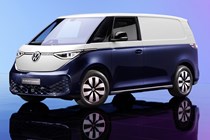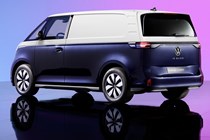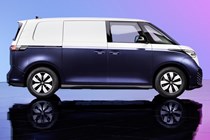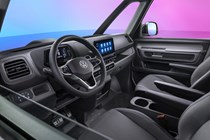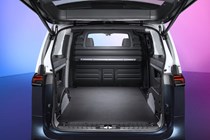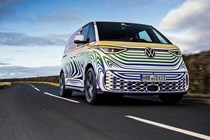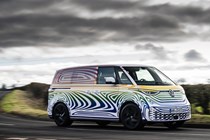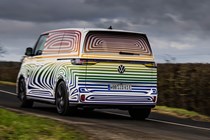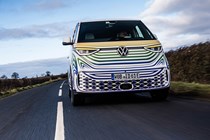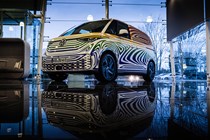The highly anticipated Volkswagen ID.Buzz Cargo will cost from £38,125 with the first models heading to customers in autumn 2022. It will be making a public appearance at the IAA Transportation 2022 show in both van and passenger format.
VW has also announced the lease rates that it is offering through its own financing arm, Volkswagen Commercial Vehicles Financial Services, with monthly payments starting at £479. Small companies and individuals will also be able to get a free 7 kW wallbox installed at their home and a £100 We Charge voucher to use across a network of public chargers.
It’s Volkswagen UK’s first proper foray into the world of electric vans, with its only other offering thus far being the rather half-hearted ABT e-Transporter. This was based on the diesel Transporter, whereas the new ID. Buzz Cargo is a totally bespoke electric van.

We’ve got plenty of details below, and we’ve also test-driven a prototype model in the UK – keep scrolling to read our initial impressions.
How much does the ID.Buzz Cargo cost and when can I buy one?
VW has finally confirmed pricing for the ID.Buzz Cargo, and it will start at £38,125 (not including VAT.)
However, this doesn’t factor in the government’s plug-in van grant, as it has yet to be confirmed whether the VW will be eligible for the scheme that could knock as much as £5,000 off the price. Watch this space on that front.
There are two versions of the ID.Buzz Cargo to choose from and, as with many other VW vans, these are called Commerce and Commerce Plus.
Commerce is the version that starts at £38,125 and brings the following kit:
- >>Three front seats
- >>Heated driver’s seat
- >>Front and rear parking sensors
- >>Ready 2 Discover infotainment system with 10-inch touchscreen
- >>Wireless App-Connect for Apple Carplay and Android Auto
- >>’Multiple’ USB-C ports
Commerce Plus starts at £42,375 and adds the following:
- >>Adaptive cruise control
- >>Keyless entry
- >>Park assist system
- >>Rear parking camera
- >>Leatherette steering wheel
- >>Sat-nav
- >>Travel assist, lane assist, side assist and emergency assist safety systems
Both versions are also offered with the first three services and the first MoT included in the price.
Volkswagen has also confirmed ID.Buzz Cargo lease prices, with the electric van available from £479 a month through Volkswagen Commercial Vehicles Financial Services. This is dependent on a £2,874 initial payment and is based on a 36-month, 10,000 a year contract.
Buyers wanting to take advantage of the free 7kW home wallbox and £100 We Charge voucher that comes as a result of the lease deal will have to take up the offer by 2 October 2022. It is restricted to individuals and small businesses – limited companies with five or more vehicles are not eligible. They’ll then have to complete the installation by 1 April 2023.
What’s under the skin of the new ID. Buzz Cargo?
The van rides on Volkswagen’s MEB electric architecture, which is the same platform that underpins its electric cars such as the ID.3 and ID.4. That should, for a while at least, afford it class-leading driving range and excellent dynamics.
Its most obvious rivals will be the quartet of electric vans based on a Stellantis platform; the Citroen e-Dispatch, Peugeot e-Expert, Vauxhall Vivaro-e and Toyota Proace Electric are excellent options, offering up to 205 miles WLTP from their 75kWh batteries.
Official range figures have now been confirmed for the ID. Buzz Cargo, with it capable of 256 miles between charges.

More interestingly, the ID. Buzz Cargo is rear-wheel drive, just like the microbus it’s inspired by. It also has a turning circle of just 11.1 metres, which is around the same as a Golf – and makes it very manoeuvrable.
Power comes from a 204hp electric motor – significantly more powerful than the Stellantis vans, and enough to give sprightly performance. And despite the bluff shape, VW’s performed aerodynamic wizardry and the ID. Buzz cuts through the air much more cleanly than you’d expect. It’ll ride on 18-inch steel wheels, though the passenger variant can have rims as large as 21-inches.
What about the load area?
The ID. Buzz is 4,712mm long, so it’s significantly shorter than the 4,892mm Transporter, but with an almost identical wheelbase. That’s been achieved by minimising overhangs – again, mimicking the Type 2 it’s inspired by.
The 1,938mm height is lower than both the Transporter and the more recently introduced Volkswagen Multivan people carrier. Both factors are good news for car parks.
The Buzz is the widest of the three, however, at 1,985mm excluding the mirrors, so width restrictors could be a bigger gamble. The packaging advantages of the electric drivetrain mean the passenger version offers plenty of room for people, but the van seems to be a little more limited for load space – just 3.9 cubic metres are available, some way short of the 5.8 cubic metres in the back of the smallest T6.1 Transporter. It can take two Euro pallets, loaded sideways.
Access is via a full-height tailgate or twin barn doors, and all versions come with two side sliding doors. A full bulkhead is standard too, with the option of a window or a load-through hatch to extend the load length underneath the passenger seats. Unlike some electric vans, the ID-Buzz Cargo is capable of towing, too – up to 1,000kg for a braked trailer.

All sounds good, right? The sticking point is still to come – payload is a lowly 650kg, which is lower than not just its Stellantis medium van competitors (which can carry more than a tonne) but their smaller siblings the e-Berlingo, e-Partner, Combo-e and Proace City Electric.
The cab is interesting, too. You’ll have the choice of two- or three-seat layouts, but all feature the same wide and low dashboard. Though it feels like you’re sat a long way back, with a large expanse of dash in front of you, the Microbus has almost no bonnet to speak of so you’re pretty close to the front of the vehicle.
There’s no leather on-board, with a plethora of recycled materials, and a few interesting storage solutions chief among which is the ‘Buzz Box’ on two-seat models – a removable centre console with storage for a laptop or clipboard and cupholders.
VW has also already announced plans to build an ID. California electric campervan.
Volkswagen ID. Buzz Cargo: prototype drive
Written by CJ Hubbard
We have since driven a production version of the VW ID.Buzz Cargo – the below report is a review of a prototype model.
It was a short drive, in a prototype with a swirling, design-detail-disguising wrap on the outside and almost entirely covered dashboard on the inside. But initial impressions are seriously encouraging. Whether you’re after a stylish, practical, zero-emissions MPV or an attention-grabbing electric van with a properly usable driving range, the ID. Buzz and ID. Buzz Cargo are going to be well worth further consideration.
Although that’s not to say there aren’t also some limitations you’ll need to deal with.
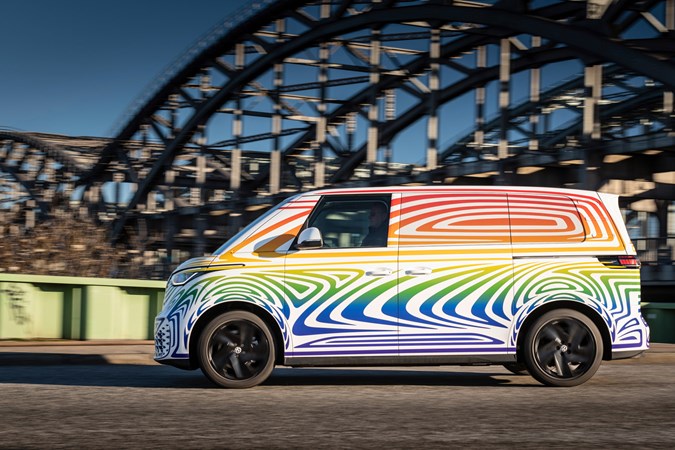
What are the technical details of the ID. Buzz?
The prototypes all have the same drivetrain: a rear-mounted 150kW electric motor, driving the rear wheels via a single-speed transmission. That’s equivalent to 204hp – the same as the most powerful diesel Transporters – with 310Nm of torque, generated instantly.
The battery here has an official 77kWh of net usable capacity (82kWh gross). Since our drive this has been confirmed as giving an official range of 256 miles. It should be possible to charge them from five to 80% in about 40 minutes using a suitably powerful public charger.
Top speed is electronically limited to 90mph, while 0-62mph takes in the region of 10 seconds by our estimates.

What’s the VW ID. Buzz like to drive?
Almost exactly like driving a futuristic VW Transporter – which is more or less exactly what we were hoping for. The height of the seating position will be familiar, but much of the rest of the experience is rather more alien, in a good way.
While almost all of the dashboard was covered for our test as we’re not allowed to know what it looks like yet, the tone of things is immediately set by the super-crisp digital instrument cluster, which is a curiously shaped tablet-style affair straight out of the other ID models – right down to the unusual drive-selector, which is mounted on the side of it.
We’re testing the Cargo version, so there’s a fixed bulkhead behind the single row of seats, and some slightly less plush interior plastics, but even the stuff on the doors feels like a step up from the usual commercial vehicle faire. This is, make no mistake, a premium product.
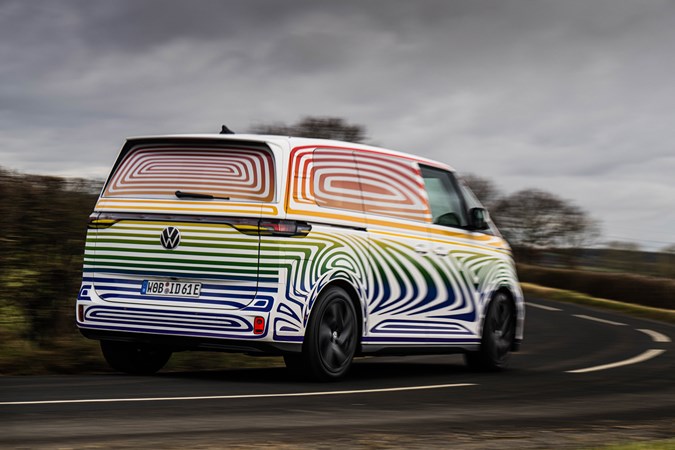
Virtually silent at low speeds, it doesn’t get much louder as you get faster – quite the contrast to a lot of other VW vans, which can typically be rather noisy inside. Remarkably, though, this isn’t the most noticeable thing about the first few yards, rather it’s the sheer manoeuvrability; with the motor at the rear making room for lots of steering lock and the wheels pushed right out to the corners, the turning circle is just over 11m, impressive for a vehicle that’s nearly 5m long.
The steering is light, too. But not to the point that Buzz ever feels nervous. Instead there’s a smooth, easy-going directness that’s effortless for tacking all kinds of roads – and gelling neatly with the smooth, easy-going performance from the electric drive system.
Unloaded and unburdened by the additional weight of the MPV’s rear seats, there’s a healthy amount of punch under your right foot. And though a hefty 2.5-tonne kerbweight means you’re unlikely to be taking your passengers’ breath away, the single-speed transmission makes the available performance superbly predictable, in a way the occasionally jerky responses of a DSG-equipped Transporter does not.
The van-spec suspension of the Cargo version is undoubtedly firm, riding on large alloy wheels hardly helping. But the long wheelbase helps iron things out, and it certainly didn’t strike us as actually uncomfortable over a very varied test route. We’re very excited to try the finished article later in the year.
Is the ID. Buzz practical as a van?
As you’ve probably clocked from the kerbweight, payload is probably going to be the limiting factor for a lot of professional van operators. There’s nothing official at this stage, but we’ve been given a projected figure of 585kg – less than some small electric vans, let alone the most obvious Stellantis family of medium electric van rivals, which can carry up to 1,200kg. This includes the reigning Parkers Electric Van of The Year, the Toyota Proace Electric.
Volkswagen is hoping to find a little more by the time the ID. Buzz Cargo hits full production spec, but clearly it’s not going to be at a level that competes with that.

>> Full Volkswagen Transporter dimensions details
Other features in the load area include six-load lashing points, various load floor options to accommodate racking systems, side rails available in three positions and barn doors in place of the tailgate favoured by the passenger variant. The bulkhead is available with a ‘load-under’ facility that accesses the space beneath the front seats to achieve an extra 450mm of loading length.
Is this more of a statement maker, then?
In many respects, yes. While VW says it has spent a lot of effort ‘making it robust’, the payload issue and the comparatively limited load space means the ID. Buzz Cargo won’t be an electric van solution that’s suitable for everyone.
As a kind of flagship for the future, Volkswagen is – unsurprisingly – making a large number of high-tech features available.
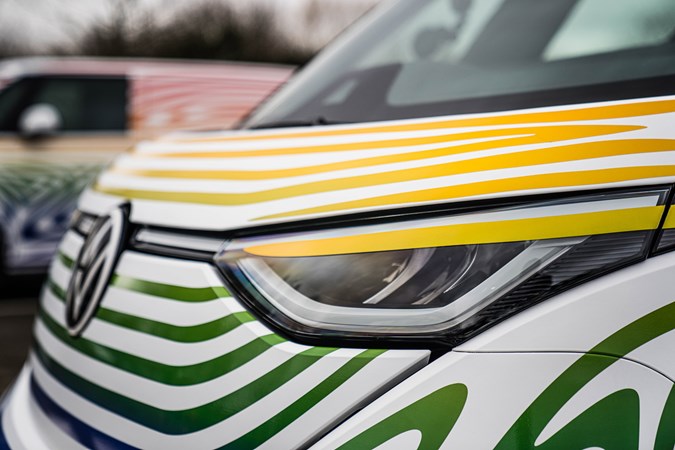
The Buzz can be fitted with IQ.Light active matrix LED headlights (non-active LEDs are standard), a car2x safety communication system, Travel Assist with ‘swarm data’ and Park Assist with a memory function.
The last two are particularly fancy, as they give the Buzz the ability to learn driving behaviour from the surrounding vehicles – such as the need to avoid driving on tram tracks – and self-parking capability that can act entirely without the driver once the intended parking space is learned.
More expected features include Hello ID voice control, a central infotainment screen up to 12.0 inches in size, wireless phone charging and up to seven USB C ports. Bi-direction vehicle charging, meanwhile, means that it can theoretically share its power back to the grid – or your house – should that be financially advantageous.
Just so you know, we may receive a commission or other compensation from the links on this website - read why you should trust us.



